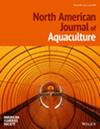Potential of Pseudomonas putida probiotic feed mixture for improving growth, immune response, and disease resistance in Nile Tilapia compared to Saccharomyces cerevisiae probiotic
IF 1.3
4区 农林科学
Q3 FISHERIES
引用次数: 0
Abstract
Abstract Objective This study aimed to assess the effects of a potential probiotic feed mixture containing Pseudomonas putida , in comparison to a yeast product ( Saccharomyces cerevisiae ), on the growth, immune response, and protection against Aeromonas hydrophila infection in Nile Tilapia Oreochromis niloticus . Methods Nile Tilapia were divided into three groups and subjected to a 60‐day feeding regimen: the first group served as a control, receiving a commercial diet; the second group received a basal diet mixed with 1 × 10 7 CFU/g diet of P. putida ; and the third group was fed a basal diet mixed with 1 g/kg diet of dried S. cerevisiae , resulting in a final concentration of 10 7 CFU/g of feeds. After 2 months of supplementation, various parameters including survival rate, body weight gain, feed conversion rate, specific growth rate, serum lysozyme activity, phagocytic activity, nitroblue tetrazolium activity, and disease resistance against A. hydrophila were evaluated. Result Both probiotic‐treated groups exhibited significant improvements compared to the control group. Specifically, enhanced survival rates, body weight gains, feed conversion rates, and specific growth rates were observed in the probiotic‐treated groups. Moreover, these groups demonstrated increased serum lysozyme, phagocytic, and nitroblue tetrazolium activities, indicative of an improved immune response. Notably, the probiotic‐treated groups displayed enhanced resistance against A. hydrophila infection. Histopathological examination revealed that P. putida significantly augmented the nonspecific immune response in Nile Tilapia. Conclusion This preliminary study underscores the potential benefits of P. putida supplementation in Nile Tilapia diets. The inclusion of P. putida resulted in enhanced growth performance, improved immune status, and effective control of A. hydrophila infection. These findings suggest that P. putida holds promise as a valuable component in feed mixtures for promoting the growth and health of Nile Tilapia.与酿酒酵母益生菌相比,恶臭假单胞菌益生菌饲料混合物在改善尼罗罗非鱼生长、免疫反应和抗病性方面的潜力
摘要目的研究含恶臭假单胞菌的益生菌饲料混合物对尼罗罗非鱼(Oreochromis niloticus)生长、免疫反应和抗嗜水气单胞菌感染的影响,并与酵母产品(酿酒酵母菌)进行比较。方法将尼罗罗非鱼分为三组,进行为期60天的饲养:第一组为对照组,饲喂商业饲料;第二组在基础饲粮中添加1 × 10 7 CFU/g恶臭假单胞菌;第三组在基础饲粮中添加1 g/kg干酿酒酵母,最终饲料浓度为10.7 CFU/g。添加2个月后,测定各组成活率、增重、饲料转化率、特定生长率、血清溶菌酶活性、吞噬活性、硝基蓝四唑活性和对嗜水单胞菌的抗病性等参数。结果与对照组相比,两个益生菌处理组均有显著改善。具体来说,在益生菌处理组中观察到存活率、体重增加、饲料转化率和特定生长率的提高。此外,这些组显示出血清溶菌酶、吞噬活性和硝基蓝四氮唑活性的增加,表明免疫反应得到改善。值得注意的是,益生菌处理组对嗜水单胞菌感染的抵抗力增强。组织病理学检查显示,恶臭杆菌显著增强尼罗罗非鱼的非特异性免疫反应。结论本初步研究强调了在尼罗罗非鱼饲料中添加恶臭假单孢菌的潜在益处。恶臭假单胞菌的加入提高了猪的生长性能,改善了猪的免疫状态,有效地控制了嗜水假单胞菌的感染。这些发现表明,恶臭杆菌有望成为饲料混合物中促进尼罗罗非鱼生长和健康的有价值成分。
本文章由计算机程序翻译,如有差异,请以英文原文为准。
求助全文
约1分钟内获得全文
求助全文
来源期刊
CiteScore
2.50
自引率
0.00%
发文量
46
审稿时长
18-36 weeks
期刊介绍:
The North American Journal of Aquaculture publishes papers on new research and practical experience in all areas of intensive and extensive fish culture. Topics include broodstock selection and spawning, nutrition and feeding, health and water quality, facilities and production technology, and the management of ponds, pens, and raceways.
The journal will consider papers dealing with ways to improve the husbandry of any aquatic species—marine or freshwater, vertebrate or invertebrate—raised for commercial, scientific, recreational, enhancement, or restoration purposes that may be of interest to practitioners in North America. Its scope includes both basic and applied science, but applied scientific endeavors—including practical experiences, descriptive studies, and other nontraditional, but pertinent works—are emphasized.

 求助内容:
求助内容: 应助结果提醒方式:
应助结果提醒方式:


